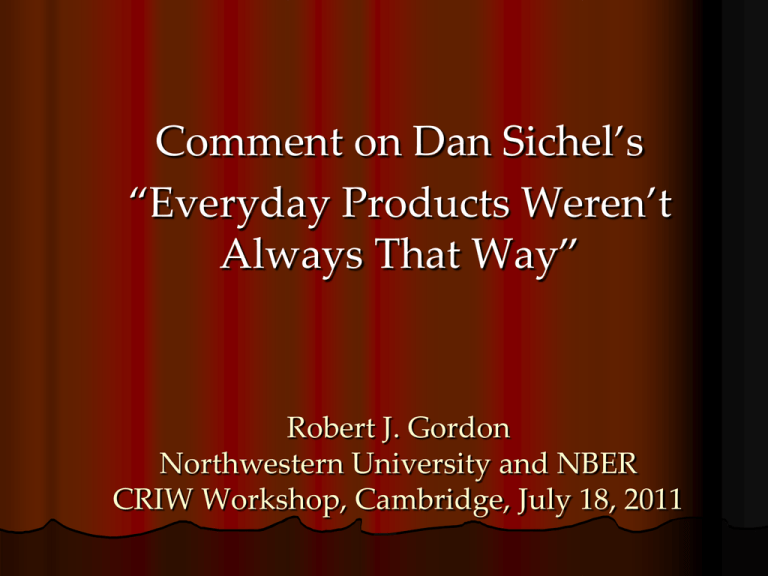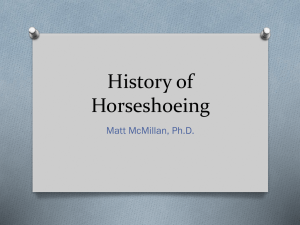"Everday Products Weren`t Always That Way" by Dan Sichel
advertisement

Comment on Dan Sichel’s “Everyday Products Weren’t Always That Way” Robert J. Gordon Northwestern University and NBER CRIW Workshop, Cambridge, July 18, 2011 New Definitions of the Long Run and of the Short Run The Long-run: Dan provides us a price index for nails covering 318 years. Is this a new Guinness world record in the history of price measurement research? The Short-run. The time interval between the delivery of Dan’s paper to the discussant last Thursday at 3pm EDT to this early Monday session spanned roughly 1.5 business days. (OK, I gave him permission) Are Nails the “Computers of the 19th Century”? Now Dan has revealed striking declines in the real price of nails, not as fast as computers but still striking. These price declines were centered on 1820-1913 Will we eventually conclude that declines in computer prices were a phenomenon that only lasted 50 years, not even a century? Analogy between nails and computers In discussing “holding power” Dan says, not all nails needed their maximum holding paper Similarly, for many users, increases in speed after 2005 have not been necessary for their desktops and laptops to function optimally Before delving into the price measurement of nails, let’s remind ourselves of the extreme outlier status of computers Computers vs. Cars, Microsoft vs. Ford Computers are the most extreme example that has ever occurred of price index bias, and the most important application of hedonic price indexes. To dramatize the results of HPI for computers, Bill Gates (or his PR flack) is alleged to have said, “If Ford had kept up with technology like the computer industry has, we would all be driving $100 cars that get 1 million miles to a gallon.” Less well known is Ford’s response . . . Broad and Short, vs. Narrow and Long. Can We Ever Do Broad and Long? One emerges from this paper with the daunting conclusion that no amount of human effort will ever get our price indexes right, once we turn from nails and screws to all the heterogenous products out there that are subjected to constant quality change along multiple dimensions. This is especially true about historical price indexes prior to 1930. I am currently involved in puzzling about U. S. economic growth during 1891-1929, and mismeasured price indexes must be part of that story. I’ll come back to that theme at the end. Extreme imagination about where to find the price data. Not only that, finds quantity data for nails and import quantity and price data. Who would have known that 70-80% of nails are now imported? He already knows the basics, where to get the best pre-1914 CPIs, and that Al Rees in 1961 was the first to use the Sears Catalogue for alternative price index research His brilliant literary detour with his quote from Little House on the Prairie. Further Praise Despite enticing us that nails are homogenous, he later shows that they are not and employs and convincing methods for quality adjustment. Interesting comparison – computers speed and memory, for nails only one quality dimension is necessary, holding power. Supplements analysis of quality change in nails with his treatment of nail guns as an important invention in the construction industry. Cites without comment on p. 30 a quote that “the screw and the screwdriver were the most important invention of the second millenium.” I guess that means years 1000-1999. This is total baloney and Dan should have said so. The most important inventions of the second millenium were electricity and the internal combustion engine, achieved in the amazingly short interval between 1876 and 1896. Next on the list would be running water and indoor plumbing, somewhere down the list central heating. I’ve just written a book chapter on the American standard of living in the year 1870. Living conditions in that year were truly awful along so many dimensions that most people today couldn’t fathom. Next slide tells you one reason why Was Indoor Plumbing the Greatest Invention? According to one calculation made in 1886 “a typical North Carolina housewife had to carry water 8 to 10 times each day. Washing, boiling, and rinsing a single load of laundry used about 50 gallons of water. Over the course of a year she walked 148 miles toting water and carried over 36 tons of water.” Not only was the water carried in, but dirty dish and clothes washing water had to be carried out, not to mention the unpleasant task of emptying chamberpots. Between 1870 and 1930 that huge traditional task of women was completely transformed in urban America And yet not one dime’s worth of that huge increase of consumer surplus gets into real GDP per capita. The “American System”: Its Role in the 19th Century Nail Production The Epochal Crystal Palace Exhibition in London in 1851, happened after 1st round of Dan’s innovations “Americans [were thought to be] little more than amiable backwoodsmen not yet ready for unsupervised outings on the world stage. So when the displays were erected it came as something of a surprise that the American section was an outpost of wizardry and wonder. Nearly all the American machines did things that the world earnestly wished machines to do – stamp out nails, cut stone, mold candles – but with a neatness, dispatch, and tireless reliability that left other nations blinking. . . . Cyrus McCormick displayed a reaper that could do the work of 40 men” (Bryson, 2010, pp. 22-23) Minor Problems in Dan’s Execution Relies too much on measuringworth.com for post1929 CPI. Doesn’t use CPI-RS to bridge 1967-83 period of upward CPI housing bias. 2010/1929 PCE deflator multiple 10.6, Dan’s CPI multiple 12.7. Also his quantity comparison on p. 19 that Q of nails increases by 100X 1810-2002, but population increased by 30X. Need per-capita comparisons. His p. 21 example of the 1798 $50 house is not credible (CPI in 1798 and 1910 were about the same) Further Minor Problems His overall conclusion, a price decline by a factor of 15, is hard to justify from the numbers he provides. I would say it’s about half that, maybe 8 He doesn’t do enough to link innovations to the timing of declines in his price series He doesn’t cite previous work on the upward drift of Sears prices compared to the CPI/WPI in the postwar years Where Did the Decline by a Factor of 15 Come From? To choose an important year in the 18th century, 1776, the real price of nails in Dan’s data appendix is 1.62. At the postwar peacetime trough in 1931, the real price was 0.19. This is a ratio of 8.5, not 15. And wire nails have about half the holding capacity of handmade 1776 nails. So where did the 15X come from? Four different price indexes are plotted in Figs 3a 3b 4a 4b, but only 4b is presented in data appendix. He gets 15X from matched model index, comparing 2.77 in 1742 with 0.17 in 1944 (WWII price controls). But matched model index links cut nails to wire nails and ignores differences in holding capacity Paper Doesn’t Focus on Two Stages of Real Price Decline How much of real price decline in nails had occurred by Crystal Palace exhibition of 1851? 1695 1.54, 1776 1.62, 1820 1.56, 1851 0.85, 1882 0.78, 1913 0.27, 1948 0.31, 2000 0.29, 2011 0.53 First wave of new machinery 1820-50, early enough to be noticed at CP Exhibition. This was cut nails. Second big wave 1882-1913. DS cites invention of wire nails in 1877 as the big driver. How much extra came from electrification of nail-making machinery? No progress 1913-2000, almost a century Why did the real price double 2000-2011? Depreciation of dollar? Did domestic nail prices differ from imported nail prices? 70-80% were imported. Methodology: Matched Model Indexes Much literature on problems with matched model indexes for computers and apparel. Computers: obsolescent computers are not priced to match the price-performance ratio of new computers. Thus big price drop when new models introduced. Apparel: price increases occur with new models, missed by matched models. My apparel paper shows that for womens’ dresses matched models can be applied to only about 2% of the observations Nails: matched model indexes ignore the decline in holding power of wire nails compared to cut nails. But any quality adjustment, such as Dan’s 2X, is arbitrary since in most applications the holding power of cut nails is not necessary. Dan doesn’t discuss the option of drilling in twice as many wire nails, particularly easy with nail guns. Sears vs. WPI On pp. 17-18 Sears tracks WPI relatively closely until 1940, then rises I found the same thing for womens’ apparel Problems Dan finds this upward drift for nails not screws I found it for womens’ apparel but not mens’ The Broader Issues Raised By This Paper Basic finding, big decline in real price of nails and screws since 1820. The paper doesn’t raise the obvious question, how many other products had massive unmeasured price declines in the 19th and 20th centuries, thus making the denominator (CPI) invalid? It is possible that any product that made the transition from hand-made to manufactured could have had a similar decline in real price An Initial Reaction to this Point: Durable Goods Were Not Important Even if all durable goods price indexes are upward biased over 1850-1930, that’s no problem because so little spending was on durable goods Typical household budget studies show this pattern of spending in late 19th century: 50% food, 20% clothing and fuel, 22% rent, 8% everything else, not all durables How important in late 19th century were goods recently transformed from hand-made to machine made? Factoids about America in 1870 Housing in 1870. Recently introduced “balloon framing” (taking advantage of cheaper nails) reduced cost of building a farm house by 40% Apparel in 1870. Roughly 2/3 made at home, 1/3 bought on the market at small retailers and general stores. Sewing machine had not yet been invented A huge price decrease in the real cost of apparel occurred with the invention of the sewing machine and transition to mail-order catalogues and department stores, 1870-2000. This transition raises important issues in the valuation of home production (esp. of food and clothing) But the Main Point Involves Durable Goods The transition from hand-made to machinemade goods can apply to all consumer durable goods Just as Dan shows us that there was a multi-fold decrease in the real price of nails, the possibility that this occurred to many other durable goods changes the interpretation of the denominator that converts nominal to real Best way to be convinced, dive into the Sears catalog of 1908 The Incredible Sears Catalogue of 1908 Let us admire the bravado of the back cover with its drawing of a building that looks distinctly larger than the 1930 Merchandise Mart “40-acre Home of Sears, Roebuck, and Co. The Largest Mercantile Plant in the World.” And, to the amazement of 100% of current Amazon employees, every one of those thousands of daily orders was fulfilled without the use of a single computer. Every order was hand-scribbled and delivered by USPS. Outlet Substitution Bias Goes Back Before Wal-Mart Hausman has provided evidence of a 25% drop in food prices when Wal-Mart comes to town. Sears’ 1908 preamble cites savings of 20 to 30%. This includes downward price pressure on competitors, as in his 1908 example of a “top buggy” previously sold for $150, now available at Sears for $50. Similar order-of-magnitude reductions claimed by Sears in this time interval for bicycles and sewing machines From Sears 1908 Catalog, Products that Were Being Mechanized In assessing prices below, PCE/CPI 2010/1908 is 18.1. All of these had been mechanized. Previously they didn’t exist or were hand-made Shotguns, indoor plumbing fixtures, stoves, sewing machines ($7.58), house paint (“we make our own” $0.59 per gallon), camels’ hair 2” paint brushes ($0.29), two-seater “road wagon” ($25.95), buggy (with a top but not a fringe, $44.95), 4-seat surrey with a fringe on top ($59.95), plain English leather saddle ($2.98), Kenwood bicycle ($11.95), More items from 1908 Sears catalog 50 stereoscopic view of SF 1906 earthquake (75c), gold-filled spectacles ($1.98), opera glasses ($2.25), disc records ($2.50 per dozen), telephone ($10.80), upright piano ($87.50), violins ($1.85 to $26), solid silver pocket watch ($1.98), 26-piece plated silver dinner set ($9.28), solid elm rotating desk chair ($4.58), solid oak kitchen cabinet 90” high by 48” wide ($9.75), solid ash ice box, 53” high ($15.85). Each of these products raise the question, how would we create a price index between 1908 and today? Solid ash ice box? Conclusion: Dan’s Research Opens the Floodgates of Speculation Did durable goods prices decrease much faster than measured WPIs in the pre-1914 no-CPI era? How should we deal with the outlet substitution bias as the department store and mail-order catalog replaced the small general store 1870-1929? Is there ultimately any solution to the deep conundrum in the history of U.S. real GDP per capita? This is shown on the next slide. Growth rates over intervals are between years of roughly “normal” business cycle activity. Output gaps make sense. The Mysterious History of U. S. Growth in Real GDP per Capita Real GDP per Capita, Growth Rates over Intervals, 1872-2027 3 2.5 Percent per year 2 1.5 1 0.5 0 1872-1891 1891-1913 1913-1928 1928-1954 1954-1987 1987-2007 2007-2027









